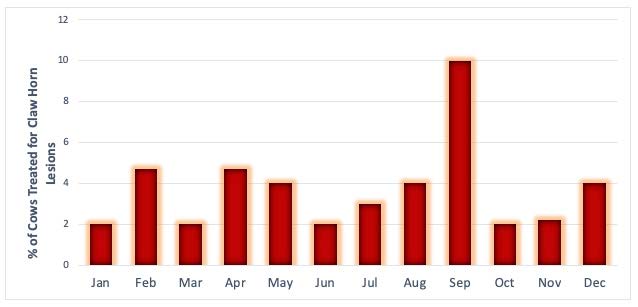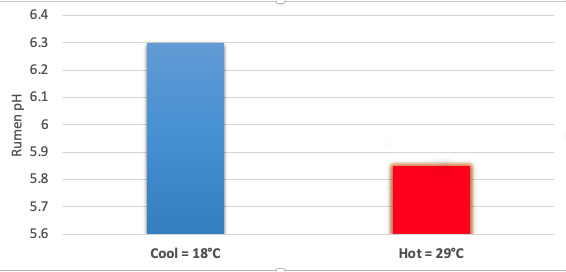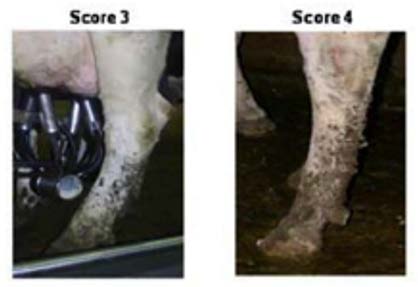Ruminant Nutritionist,
Grand Valley Fortifiers, Nutrition Direct
Figure 1. Incidence of lameness peaks at the end of summer –
highest temperatures were in July. (Adapted from NB Cook, 2004)

Table 1. Locomotion Scoring Guide (adapted from Sprecher et al, 1997)
| Score | Description | Back | Assessment |
| 1 | Normal | Flat | Stands and walks normally with a level back. Makes long, confident strides. |
| 2 | Mildly lame | Flat or arched | Stands with flat back, but arches when walks. Gait is slightly abnormal. |
| 3 | Moderately lame | Arched | Stands and walks with an arched back and short strides with one or more legs. Slight sinking in dew-claws in limb opposite the affected limb may be evident. |
| 4 | Lame | Arched | Arched back standing and walking. Favoring one or more limbs but can still bear some weight on them. Sinking of the dew-claws is evident in limb opposite to the affected limb. |
| 5 | Severely lame | Arched | Pronounced arching of back. Reluctant to move, with almost complete weight transfer off the affected limb. |
Figure 2. Ruminal response to heat stress (adapted from Mishra et al, 1970).

The same study went on to show that in barns where severe lameness occurred, the incidence increased with the number of manure contaminated stalls and the use of sawdust bedding. Other factors that helped reduce the incidence was a having a neck rail further from the curb (lower perching tendency), greater water drinking space per cow and frequency of foot baths per week. However, if the barn is overcrowded then improving drinking space and stall size no longer had as much of an impact.
Footbathing has become a big part of managing hoof health but doing it correctly will make the time and money much more well spent. Ultimately the goal of footbathing is to prevent infectious claw lesions that lead to depressed cow movements and thus production. For footbaths to be truly effective it is important to understand the lesion on the cow. M1 lesions are early, subclinical and small measuring <0.75” and they are susceptible to improvement with footbaths. M2 are more painful, acute lesions >0.75” and they require treatment.
Establishing how often footbathing should be done on your farm can be estimated based on how clean cow’s legs are. There is a strong relationship between leg hygiene and infectious claw disease so a nice visual cue to stay on top of things. A score of 3 (moderately dirty with distinct plaques of manure on the foot, progressing up the limb) and a score of 4 (very dirty with lots of caked-on manure on the foot and higher up on the lower limb (see Figure 3).

| Proportion of Cow Hygiene 3&4 | Footbath frequency |
| <25% | As required |
| 25-50% | 2 days/week |
| 51-75% | 5 days/week |
| >75% | 7 days/week |
- Side walls sloped outwardly 70o angle to ensure cattle get feet in the bath (treated) with every step or high walls (3 ft) with optimally one wall able to come down should a cow fall.
- Length – 10 to 12 ft to allow 2 full immersions in the bath
a. 6 ft bath likely to get 2 full immersions 53% of the time.
b. 8 ft bath likely to get 2 full immersions 84% of the time.
c. 10 ft bath likely to get 2 full immersions 96% of the time. - Step in height should be 10 inches – a study showed that this height (compared to 5 in) allowed more chemical to stay in the footbath.
- Footbath should be at least 24 inches wide.
Solutions recommended for footbaths are Formalin (2-3% dilution) which is effective long term since bacteria do not tend to develop resistance but should be used with protective gear to avoid harm to people and is not very effective in cool weather (<7C or 45F). Copper sulphate (3-5%) is a nice antibacterial/hardening agent that is mostly soluble though its dilution in water is improved when acidified. The pH of the solution should not be below 3.0 (normal pH of bovine skin is 3.6). A solution of Zinc sulfate (10-20%) can also be used with similar benefits to copper sulfate but it is much less soluble so again acidification will help. Lastly, soap and water should always be a part of the regime to simply improve that leg hygiene. For other effective footbath products visit our farmersdepot.ca website and search “hoof bath”. Changing the footbath is recommended when aerobic bacteria load reaches above 100,000 cfu/mL which is tough to measure looking at the bath so the estimation is 100 cow passes.
Footbath errors are the biggest impediment to their ineffectiveness. Managing the regime to avoid poor design, too weak or too strong chemical solution, and areas of urine/manure accumulation after the footbath. Keeping a good management schedule throughout the year will help alleviate chronic problems in the herd and come the summer months when there is more pressure put on their feet it becomes a very important part to avoiding Fall Hoof Health problems.
This article was written for the Winter 2022 Dairy Eastern Dairy Grist. To read the whole Dairy Grist, click the button below.

